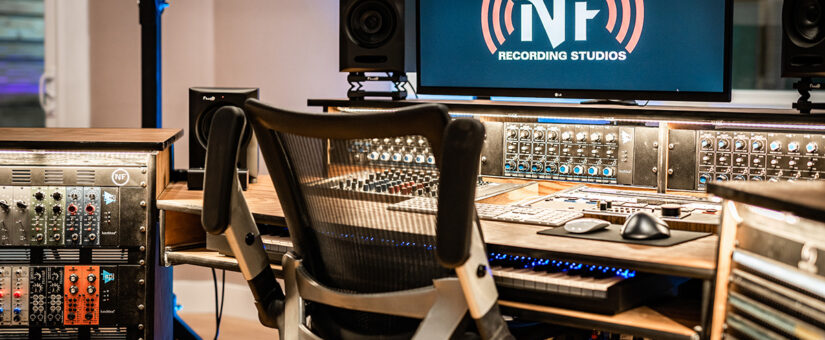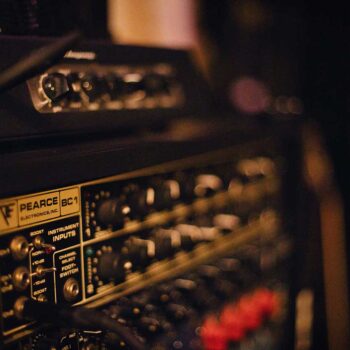
The control room desk in a recording studio is more than just a piece of furniture; it’s a critical element that affects both the ergonomics of the workspace and the overall efficiency of audio production. The design and layout of this desk are integral to ensuring that audio engineers and producers can work comfortably and effectively for extended periods. In this comprehensive guide, we will explore the principles of ergonomics and design for a control room desk, providing insights and best practices for creating a workspace that enhances productivity and reduces strain.
Understanding the Role of the Control Room Desk
Function and Importance
The control room desk is the central hub in a recording studio where audio engineers mix, edit, and master recordings. It supports a range of equipment, including mixing consoles, audio interfaces, monitors, and control surfaces. The design of the desk impacts how easily engineers can access their tools and manage their workflow, making ergonomics and design crucial considerations.
Key Components
- Mixing Console: The primary piece of equipment used to control audio levels, panning, and effects.
- Audio Interfaces: Devices that connect various audio sources to the computer.
- Control Surfaces: Hardware that provides tactile control over digital audio workstations (DAWs).
- Monitors: Loudspeakers used for accurate sound monitoring.
Principles of Ergonomics in Desk Design
Adjustable Height and Angle
Importance of Adjustability
An ergonomic control room desk should allow for adjustments in height and angle to accommodate different tasks and user preferences. This helps in maintaining a comfortable posture and reducing strain:
- Height Adjustment: Allows users to align the desk with their chair height, promoting good posture and reducing back pain.
- Angle Adjustment: Enables engineers to adjust the angle of the desk surface for optimal viewing and access to controls.
Implementation
- Desk Stands: Use adjustable desk stands or risers to modify the height of the desk.
- Tiltable Surfaces: Incorporate tiltable or angled surfaces to improve the ergonomics of working with mixing consoles and control surfaces.
Optimal Reach and Accessibility
Importance of Reach and Accessibility
The desk design should ensure that all equipment and controls are within easy reach to minimize unnecessary stretching or twisting. This improves efficiency and reduces the risk of repetitive strain injuries:
- Control Placement: Place frequently used controls and equipment within the primary reach zone to reduce movement and increase efficiency.
- Cable Management: Implement cable management solutions to avoid clutter and ensure easy access to connections.
Implementation
- Reach Zones: Design the desk with different reach zones in mind. The primary zone (within 18 inches) should include frequently used controls.
- Cable Channels: Include built-in cable channels or management systems to keep cables organized and accessible.
Comfortable Seating and Posture
Importance of Seating and Posture
Comfortable seating and proper posture are essential for long hours of work. The desk design should complement ergonomic chairs and support a healthy posture:
- Chair Compatibility: Ensure the desk height and design are compatible with ergonomic chairs that provide adequate lumbar support.
- Footrest: Incorporate a footrest if necessary to support proper posture and reduce leg strain.
Implementation
- Chair Clearance: Design the desk with sufficient clearance for ergonomic chairs, allowing for easy movement and adjustment.
- Footrests: Provide space for footrests or ensure that the desk height allows users to rest their feet flat on the ground.
Visual and Auditory Ergonomics
Importance of Visual and Auditory Ergonomics
Good visual ergonomics help reduce eye strain and ensure that monitors and controls are positioned for optimal visibility. Auditory ergonomics focus on reducing noise and improving the clarity of sound:
- Monitor Placement: Position monitors at eye level and at an appropriate distance to prevent neck strain and eye fatigue.
- Acoustic Treatment: Implement acoustic treatments to control reflections and improve sound clarity in the control room.
Implementation
- Monitor Mounts: Use adjustable monitor mounts to position screens at eye level and adjust for optimal viewing angles.
- Acoustic Panels: Install acoustic panels around the desk area to manage reflections and improve sound clarity.
Design Considerations for a Control Room Desk
Space Utilization
Importance of Efficient Space Utilization
A well-designed control room desk should maximize space utilization to ensure that all equipment is organized and accessible without cluttering the workspace:
- Surface Area: Provide ample surface area for equipment while allowing space for documents, keyboards, and other accessories.
- Storage Solutions: Incorporate storage solutions to keep essential tools and materials within reach but out of the way.
Implementation
- Modular Design: Use a modular desk design to accommodate different equipment and adapt to changing needs.
- Drawers and Shelves: Include drawers and shelves for storing accessories and reducing surface clutter.
Aesthetic and Functional Design
Importance of Aesthetic and Functional Design
The desk should not only be functional but also visually appealing. A well-designed desk enhances the overall look of the studio and contributes to a positive working environment:
- Materials and Finishes: Choose materials and finishes that are durable and complement the studio’s aesthetic.
- Ergonomic Accessories: Incorporate ergonomic accessories, such as wrist rests and adjustable monitor stands, to enhance comfort and functionality.
Implementation
- Custom Finishes: Select custom finishes and materials that match the studio’s design and provide a professional appearance.
- Accessory Integration: Design the desk to integrate ergonomic accessories seamlessly without compromising its functionality.
Integration with Studio Workflow
Importance of Workflow Integration
The desk design should align with the studio’s workflow to enhance efficiency and productivity. This involves integrating equipment and controls in a way that supports the recording and mixing processes:
- Workflow Optimization: Arrange equipment and controls in a logical order that reflects the typical workflow of the studio.
- Communication Tools: Include communication tools, such as intercom systems or talkback microphones, to facilitate interaction between the control room and live room.
Implementation
- Equipment Layout: Position equipment based on its role in the workflow, ensuring that frequently used items are easily accessible.
- Integrated Communication: Incorporate integrated communication tools into the desk design to streamline studio operations.
Flexibility and Adaptability
Importance of Flexibility and Adaptability
A flexible and adaptable desk design can accommodate changes in technology and studio requirements, ensuring long-term usability:
- Modular Components: Use modular components that can be easily reconfigured or upgraded as needed.
- Adjustable Features: Include adjustable features to accommodate different equipment and user preferences.
Implementation
- Modular Design: Design the desk with modular components that can be added or removed as needed.
- Adjustable Panels: Incorporate adjustable panels or surfaces to accommodate different types of equipment and configurations.
Practical Tips for Designing an Ergonomic Control Room Desk
Assess Your Needs
Importance of Needs Assessment
Before designing the desk, assess the specific needs of the studio and its users. This includes understanding the types of equipment used, the workflow, and individual preferences:
- Equipment Requirements: Identify the types and quantities of equipment that will be used on the desk.
- User Preferences: Consider the preferences and ergonomics of the users who will be working at the desk.
Implementation
- User Surveys: Conduct surveys or interviews with studio users to gather information about their preferences and requirements.
- Equipment Inventory: Create an inventory of equipment to ensure that the desk design accommodates all necessary items.
Collaborate with Professionals
Importance of Professional Collaboration
Working with professionals, such as ergonomic designers and studio architects, can ensure that the desk design meets both ergonomic and aesthetic standards:
- Expert Advice: Seek advice from experts to ensure that the desk design complies with ergonomic principles and studio requirements.
- Custom Design: Consider custom design solutions that address specific needs and constraints.
Implementation
- Consultation: Engage with ergonomic designers and studio architects to discuss design options and receive professional input.
- Custom Solutions: Explore custom design options to address unique requirements and preferences.
Test and Refine
Importance of Testing and Refinement
Testing the desk design in practice can help identify any issues and refine the design for optimal performance:
- Prototype Testing: Create prototypes or mock-ups of the desk to test its functionality and ergonomics.
- User Feedback: Collect feedback from users to identify areas for improvement and make necessary adjustments.
Implementation
- Prototype Development: Develop prototypes or mock-ups of the desk to evaluate its design and functionality.
- User Testing: Conduct user testing to gather feedback and make refinements to the design.
Conclusion
The design and ergonomics of a control room desk are essential for creating a productive and comfortable recording environment. By focusing on principles of ergonomics, space utilization, aesthetic and functional design, workflow integration, and flexibility, you can create a desk that enhances efficiency, reduces strain, and supports the needs of audio engineers and producers. Whether you’re designing a new studio or updating an existing workspace, these considerations will help you achieve the best possible results.
- On 09/13/2024


